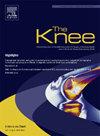The tensile strength of different methods of anterior cruciate ligament graft end stitches in an animal model
IF 2
4区 医学
Q3 ORTHOPEDICS
引用次数: 0
Abstract
Background
There are several methods for stitching graft ends in anterior cruciate ligament reconstructive surgery. The tendon-suture construct should be able to withstand tensioning until the graft is stabilized with an implant.
Methods
In this biomechanical study, 40 porcine lower extremity tendons ends were stitched with No. 2 suture, secured to the grips of the Zwick-Roell testing machine and tested for load at failure and type of failure (tendon v/s suture thread). The applied force was linear, the results are given in Newtons (N) as a mean. The Mann-Whitney U test was used for statistical analysis. The following constructs were compared: a whipstitch of each tendon end individually with 3, 4, and 5 passes through the tendon, a whipstitch of both tendon ends folded together and a tendon end knot without stitching.
Results
All specimens survived the minimum tensile load of 80 N. The load at failure for whipstitch with 3,4 and 5 passes were 175 N, 211 N and 254 N respectively. The load at failure was greater for individual whipstitch than for both ends folded together (261 N v/s 152 N). The mean load at failure for braided graft was 209 N. The braided graft slips off the tendon before failure leading to uneven strength distribution during tensioning.
Conclusion
Increasing number of suture passes resulted in higher load at failure. Individual tendon ends whipstitched with 5 passes was the strongest construct. All of the investigated techniques are sufficient to withstand the suggested optimal graft tension of 80 N.
不同方法的前交叉韧带移植物末端缝线在动物模型上的抗拉强度
背景在前交叉韧带重建手术中,有几种缝合移植物末端的方法。肌腱缝合结构应该能够承受张力,直到移植物被植入物稳定。方法采用2号线缝合40只猪下肢肌腱末端,固定在Zwick-Roell试验机的握把上,测试失效载荷和失效类型(肌腱v/s缝线)。所施加的力是线性的,结果以牛顿(N)为平均值。采用Mann-Whitney U检验进行统计分析。比较了以下结构:每个肌腱末端分别有3、4和5穿过肌腱的鞭针,两个肌腱末端折叠在一起的鞭针和不缝合的肌腱末端结。结果所有试件均能承受80 N的最小拉伸载荷,3次、4次和5次的失效载荷分别为175 N、211 N和254 N。单根绳结的破坏载荷大于两端折叠在一起的破坏载荷(261 N v/s, 152 N)。编织移植物的平均破坏载荷为209 N。编织移植物在破坏前从肌腱上脱落,导致张力分布不均匀。结论缝合次数越多,失败时负荷越大。单个肌腱末端用5道鞭缝是最强的构造。所有研究的技术都足以承受建议的最佳接枝张力80 N。
本文章由计算机程序翻译,如有差异,请以英文原文为准。
求助全文
约1分钟内获得全文
求助全文
来源期刊

Knee
医学-外科
CiteScore
3.80
自引率
5.30%
发文量
171
审稿时长
6 months
期刊介绍:
The Knee is an international journal publishing studies on the clinical treatment and fundamental biomechanical characteristics of this joint. The aim of the journal is to provide a vehicle relevant to surgeons, biomedical engineers, imaging specialists, materials scientists, rehabilitation personnel and all those with an interest in the knee.
The topics covered include, but are not limited to:
• Anatomy, physiology, morphology and biochemistry;
• Biomechanical studies;
• Advances in the development of prosthetic, orthotic and augmentation devices;
• Imaging and diagnostic techniques;
• Pathology;
• Trauma;
• Surgery;
• Rehabilitation.
 求助内容:
求助内容: 应助结果提醒方式:
应助结果提醒方式:


